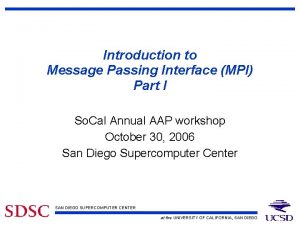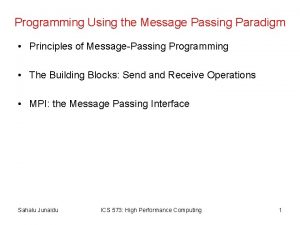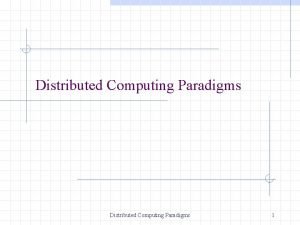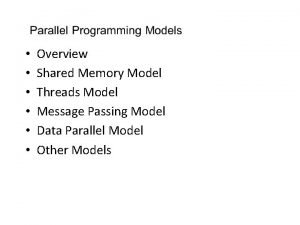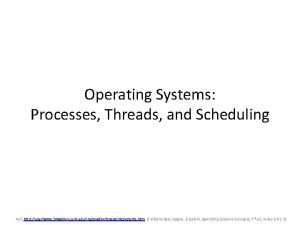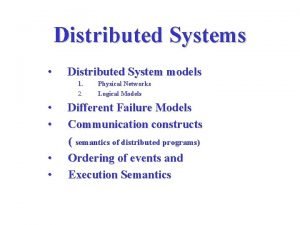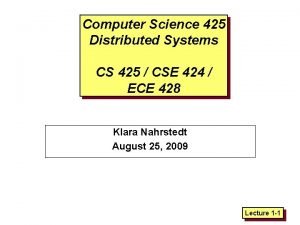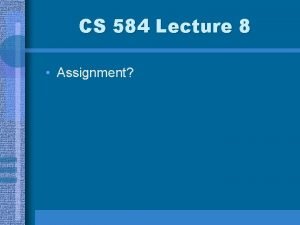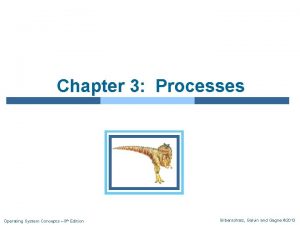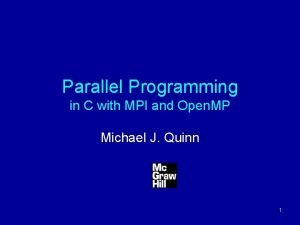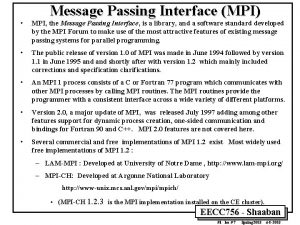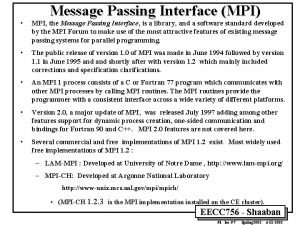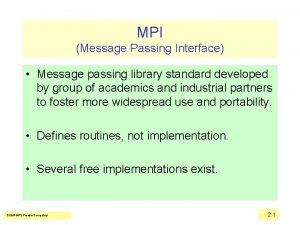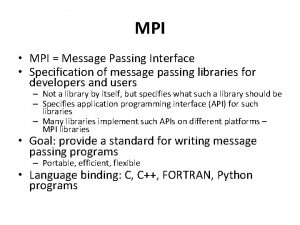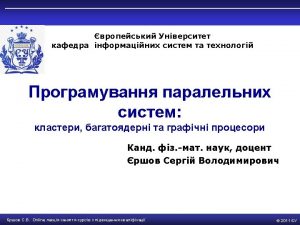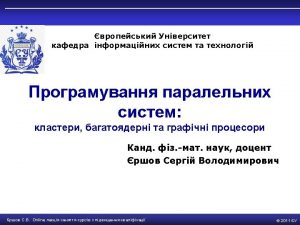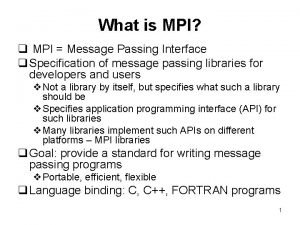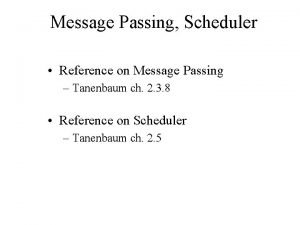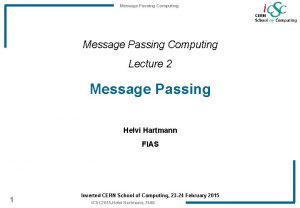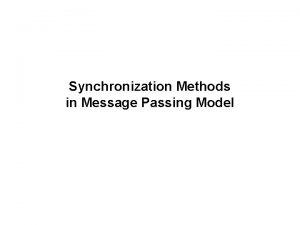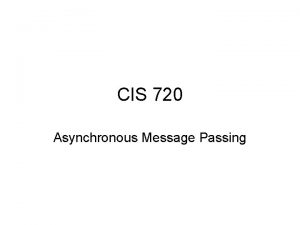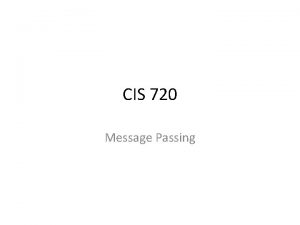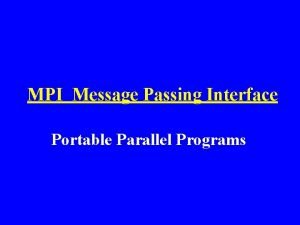Message Passing Programming with MPI Introduction to MPI

















![SOR: MPI version • How to partitioning the arrays? – double grid[n+1][n/p+1], temp[n+1][n/p+1]; SOR: MPI version • How to partitioning the arrays? – double grid[n+1][n/p+1], temp[n+1][n/p+1];](https://slidetodoc.com/presentation_image_h/d736c4196913bd569c1b7c3204d60362/image-18.jpg)
![SOR: MPI version Receive grid[1. . n][0] from the process myid-1; Receive grid[1. . SOR: MPI version Receive grid[1. . n][0] from the process myid-1; Receive grid[1. .](https://slidetodoc.com/presentation_image_h/d736c4196913bd569c1b7c3204d60362/image-19.jpg)
![Sequential Matrix Multiply For (I=0; I<n; I++) for (j=0; j<n; j++) c[I][j] = 0; Sequential Matrix Multiply For (I=0; I<n; I++) for (j=0; j<n; j++) c[I][j] = 0;](https://slidetodoc.com/presentation_image_h/d736c4196913bd569c1b7c3204d60362/image-20.jpg)
- Slides: 20

Message Passing Programming with MPI • Introduction to MPI • Basic MPI functions • Most of the MPI materials are obtained from William Gropp and Rusty Lusk’s MPI tutorial at http: //www. mcs. anl. gov/mpi/tutorial/

Message Passing Interface (MPI) • MPI is an industrial standard that specifies library routines needed for writing message passing programs. – Mainly communication routines – Also include other features such as topology. • MPI allows the development of scalable portable message passing programs. – It is a standard supported pretty much by everybody in the field.

• MPI uses a library approach to support parallel programming. – MPI specifies the API for message passing (communication related routines) – MPI program = C/Fortran program + MPI communication calls. – MPI programs are compiled with a regular compiler(e. g gcc) and linked with an mpi library.

MPI execution model • Separate (collaborative) processes are running all the time. – ‘mpirun –machinefile machines –np 16 a. out’ The same a. out is executed on 16 machines. – Different from the Open. MP model. • What about the sequential portion of an application?

MPI data model • No shared memory. Using explicit communications whenever necessary. • How to solve large problems – Logically partition the large array and logically distribute the large array into processes.

• MPI specification is both simple and complex. – Almost all MPI programs can be realized with six MPI routines. – MPI has a total of more than 100 functions and a lot of concepts. – We will mainly discuss the simple MPI, but we will also give a glimpse of the complex MPI. • MPI is about just the right size. – One has the flexibility when it is required. – One can start using it after learning the six routines.

The hello world MPI program #include "mpi. h" #include <stdio. h> int main( int argc, char *argv[] ) { MPI_Init( &argc, &argv ); printf( "Hello worldn" ); MPI_Finalize(); return 0; } • • Mpi. h contains MPI definitioins and types. MPI program must start with MPI_init MPI program must exit with MPI_Finalize MPI functions are just library routines that can be used on top of the regular C, C++, Fortran language constructs.

Compiling, linking and running MPI programs • MPICH is installed on linprog • To run a MPI program, do the following: – Create a file called. mpd. conf in your home directory with content ‘secretword=cluster’ – Create a file ‘hosts’ specifying the machines to be used to run MPI programs. – – Boot the system ‘mpdboot –n 3 –f hosts’ Check if the system is corrected setup: ‘mpdtrace’ Compile the program: ‘mpicc hello. c’ Run the program: mpiexec –machinefile hostmap –n 4 a. out • Hostmap specifies the mapping • -n 4 says running the program with 4 processes. – Exit MPI: mpdallexit

Login without typing password • Key based authentication • Password based authentication is inconvenient at times – Remote system management – Starting a remote program (starting many MPI processes!) – …… • Key based authentication allows login without typing the password. – Key based authentication with ssh in UNIX • Remote ssh from machine A to machine B Step 1: at machine A: ssh-keygen –t rsa (do not enter any pass phrase, just keep typing “enter”) Step 2: append A: . ssh/id_rsa. pub to B: . ssh/authorized_keys

• MPI uses the SPMD model (one copy of a. out). – How to make different process do different things (MIMD functionality)? • Need to know the execution environment: Can usually decide what to do based on the number of processes on this job and the process id. – How many processes are working on this problem? » MPI_Comm_size – What is myid? » MPI_Comm_rank » Rank is with respect to a communicator (context of the communication). MPI_COM_WORLD is a predefined communicator that includes all processes (already mapped to processors).

Sending and receiving messages in MPI • Questions to be answered: – To who are the data sent? – What is sent? – How does the receiver identify the message

• Send and receive routines in MPI – MPI_Send and MPI_Recv (blocking send/recv) – Identify peer: Peer rank (peer id) – Specify data: Starting address, datatype, and count. • An MPI datatype is recursively defined as: – predefined, corresponding to a data type from the language (e. g. , MPI_INT, MPI_DOUBLE) – a contiguous array of MPI datatypes – a strided block of datatypes – an indexed array of blocks of datatypes – an arbitrary structure of datatypes – There are MPI functions to construct custom datatypes, in particular ones for subarrays – Identifying message: sender id + tag

MPI blocking send MPI_Send(start, count, datatype, dest, tag, comm) • The message buffer is described by (start, count, datatype). • The target process is specified by dest, which is the rank of the target process in the communicator comm. • When this function returns, the data has been delivered to the system and the buffer can be reused. The message may not have been received by the target process.

MPI blocking receive MPI_Recv(start, count, datatype, source, tag, comm, status) • Waits until a matching (both source and tag) message is received from the system, and the buffer can be used • source is rank in communicator specified by comm, or MPI_ANY_SOURCE (a message from anyone) • tag is a tag to be matched on or MPI_ANY_TAG • receiving fewer than count occurrences of datatype is OK, but receiving more is an error (result undefined) • status contains further information (e. g. size of message, rank of the source) • See pi_mpi. c and jacobi_mpi. c for the use of MPI_Send and MPI_Recv.

• The Simple MPI (six functions that make most of programs work): – MPI_INIT – MPI_FINALIZE – MPI_COMM_SIZE – MPI_COMM_RANK – MPI_SEND – MPI_RECV – Only MPI_Send and MPI_Recv are non-trivial.

The MPI PI program h = 1. 0 / (double) n; sum = 0. 0; for (i = myid + 1; i <= n; i += numprocs) { x = h * ((double)i - 0. 5); sum += 4. 0 / (1. 0 + x*x); } mypi = h * sum; h = 1. 0 / (double) n; sum = 0. 0; for (i = 1; i <= n; i++) { x = h * ((double)i - 0. 5); sum += 4. 0 / (1. 0 + x*x); } mypi = h * sum; if (myid == 0) { for (i=1; i<numprocs; i++) { MPI_Recv(&tmp, 1, MPI_DOUBLE, i, 0, MPI_COMM_WORLD, &status); mypi += tmp; } } else MPI_Send(&mypi, 1, MPI_DOUBLE, 0, 0, MPI_COMM_WORLD); /* see pi_mpi. c */

SOR: sequential version
![SOR MPI version How to partitioning the arrays double gridn1np1 tempn1np1 SOR: MPI version • How to partitioning the arrays? – double grid[n+1][n/p+1], temp[n+1][n/p+1];](https://slidetodoc.com/presentation_image_h/d736c4196913bd569c1b7c3204d60362/image-18.jpg)
SOR: MPI version • How to partitioning the arrays? – double grid[n+1][n/p+1], temp[n+1][n/p+1];
![SOR MPI version Receive grid1 n0 from the process myid1 Receive grid1 SOR: MPI version Receive grid[1. . n][0] from the process myid-1; Receive grid[1. .](https://slidetodoc.com/presentation_image_h/d736c4196913bd569c1b7c3204d60362/image-19.jpg)
SOR: MPI version Receive grid[1. . n][0] from the process myid-1; Receive grid[1. . n][n/p] from process myid+1; Send grid[1. . n][1] to process myid-1; Send grid[1. . n][n/p-1] to process myid+1; For (i=1; i<n; i++) for (j=1; j<n/p; j++) temp[i][j] = 0. 25* (grid[i][j-1]+grid[i][j+1] + grid[i-1][j] + grid[i+1][j]);
![Sequential Matrix Multiply For I0 In I for j0 jn j cIj 0 Sequential Matrix Multiply For (I=0; I<n; I++) for (j=0; j<n; j++) c[I][j] = 0;](https://slidetodoc.com/presentation_image_h/d736c4196913bd569c1b7c3204d60362/image-20.jpg)
Sequential Matrix Multiply For (I=0; I<n; I++) for (j=0; j<n; j++) c[I][j] = 0; for (k=0; k<n; k++) c[I][j] = c[I][j] + a[I][k] * b[k][j]; MPI version? How to distribute a, b, and c? What is the communication requirement?
 Mpi message passing interface tutorial
Mpi message passing interface tutorial Principles of message passing programming
Principles of message passing programming Desirable features of a good message passing system
Desirable features of a good message passing system Divergence of darkness
Divergence of darkness Distributed paradigm
Distributed paradigm Message passing
Message passing Distributed operating system ppt
Distributed operating system ppt Message passing model
Message passing model Variational message passing
Variational message passing Message passing game
Message passing game Message passing system
Message passing system Physical model in distributed system
Physical model in distributed system Message passing system in distributed system
Message passing system in distributed system Erlang message passing
Erlang message passing Message passing os
Message passing os Message passing interface
Message passing interface Message passing os
Message passing os Mpi parallel programming in c
Mpi parallel programming in c Perbedaan linear programming dan integer programming
Perbedaan linear programming dan integer programming Greedy programming vs dynamic programming
Greedy programming vs dynamic programming What is system programing
What is system programing
